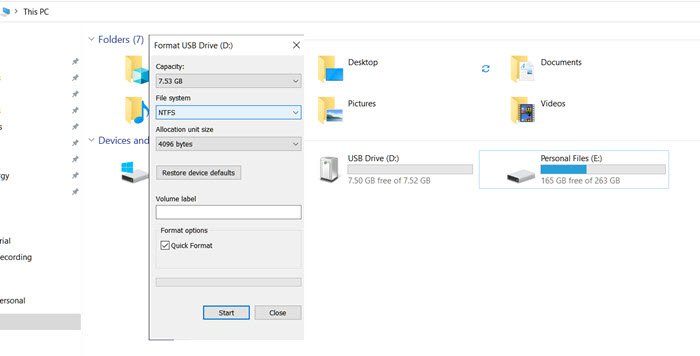

NTFS support in small, portable devices is very uncommon.
#Format usb to ntfs mac#
Mac and Linux only read it, though addons can be installed to write to it. Unfortunately, support for NTFS is less complete on other operating systems.

#Format usb to ntfs windows#
NTFS carries much more overhead information as compared to FAT32.īecause of its performance and reliability, NTFS is the choice for hard disks and removable drives accessed only by Windows systems. While FAT32 has no concept of “permissions” (other than generic “read only”, “hidden”, and “system” attributes), NTFS supports a robust, complex, and complete set of access controls at the user account and group level that can allow or deny read and write access separately, as well as access to many other characteristics. NTFS is optimized for fast, reliable, and perhaps most importantly, multi-user access. Think of it as a reference book with all the bells and whistles: table of contents, index, bibliography, footnotes, annotations, and more. The Windows system drive (typically “C:”) must be formatted with NTFS.

NTFS (New Technology File System) was introduced with Windows NT, and is the default file system used by Windows. This limitation is becoming a more common reason that other formats might be used. Individual files on a FAT32 formatted drive are limited to 4GB in size. It’s well suited to transferring data between different devices, such as your camera, your phone, or your Mac, PC, and Linux computers. All versions of Windows support it, and so do almost all other operating systems and devices that use disks. Think of it as a reference book with only a table of contents.īecause it’s been around longer (it dates back to MS-DOS and Windows 95), it’s by far the most compatible file system. FAT32įAT32 (File Allocation Table, 32 bit) is the oldest and perhaps simplest of the three. The three most common file systems you’re likely to encounter 1 are FAT32, NTFS, and exFAT. The same is true with file systems: they all store data, but organize it differently. All have the data, but with different characteristics. The same information can be published in a variety of ways. Some books are in color and have pictures others do not. Similarly, some might use large text and wide margins, resulting in less information per page, while others cram a lot of words onto each. Some include footnotes at the bottom of the page, others put them at the end, and some have no footnotes at all. Some books include only a table of contents. Regardless of the information in a reference book, it can be laid out and augmented in many different ways.

Rather, it’s to understand the differences between how file systems organize data. As with most analogies, this relies on gross oversimplification and is not intended to describe the details of how disks work. Let’s use a reference book as an analogy. The type of file system is selected and initialized when you format a drive. File systemsįile systems are how the bits and bytes of your data are organized on a disk. For USB thumb drives, FAT32 is typically the default, and is the most compatible for drives moved between machines with different operating systems. Each has strengths and weaknesses, and which is most appropriate depends on how the drive will be used. File system formats like FAT32, NTFS, and exFAT are standard ways of organizing data on hard disks.


 0 kommentar(er)
0 kommentar(er)
